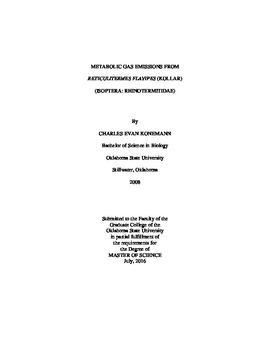| dc.contributor.advisor | Kard, Brad | |
| dc.contributor.author | Konemann, Charles E. | |
| dc.date.accessioned | 2017-02-22T22:15:24Z | |
| dc.date.available | 2017-02-22T22:15:24Z | |
| dc.date.issued | 2016-07-01 | |
| dc.identifier.uri | https://hdl.handle.net/11244/49100 | |
| dc.description.abstract | Production of metabolic gases from many species of mound-building subterranean termites have been well studied in Africa, Australia and South America. However, native North American subterranean termites, Reticulitermes spp., metabolic gas emissions have not been well defined in natural settings. This is due in part to termites not being evenly distributed in soil. Carbon dioxide (CO2) and methane (CH4) are produced from multiple sources in the soil, including subterranean termites. This was demonstrated in a field study conducted on the Joseph H. Williams Tallgrass Prairie Preserve (TGPP) in northeast Oklahoma, where gas measurements attempted to distinguish termite contributions of CO2 by studying gases emanating from soils where termites were either present or absent. It was determined that amounts of CO2 produced from overall soil biological processes obscures the smaller gas amounts produced by termites. When metabolic gases from laboratory-reared R. flavipes were studied in a controlled environment, subtle but significant changes in CO2 and CH4 emissions where measured emanating from as few as 50 termites overtime, demonstrating that termite-produced CO2 and CH4 can be detected. Using this information collected from these controlled experiments, a protocol by which direct measurements of subterranean termite metabolic gases can be made was developed for field use. Field work on the TGPP during 2014 and 2015 established that foraging R. flavipes produced significant amounts of CO2 and CH4, depending on their population density. Soils emitted no CH4 but emitted significant amounts of CO2 during the same period compared with controls. It was also established that termite activity and soil biological processes are governed by atmospheric temperature, soil temperature, and soil moisture content. Therefore, termites comprise one group of many contributors of a large and diverse community of soil organisms producing CO2. Termites appear to be the main TGPP soil arthropod group producing detectable CH4. More sensitive detection equipment and improved soil gas monitoring methods are needed to better determine accurate amounts of metabolic gases that subterranean termites contribute to total normal baseline gas emissions on the TGPP. | |
| dc.format | application/pdf | |
| dc.language | en_US | |
| dc.rights | Copyright is held by the author who has granted the Oklahoma State University Library the non-exclusive right to share this material in its institutional repository. Contact Digital Library Services at lib-dls@okstate.edu or 405-744-9161 for the permission policy on the use, reproduction or distribution of this material. | |
| dc.title | Metabolic Gas Emissions from Reticulitermes Flavipes (Kollar) (Isoptera: Rhinotermitidae) | |
| dc.contributor.committeeMember | Royer, Tom | |
| dc.contributor.committeeMember | Hiziroglu, Salim | |
| dc.contributor.committeeMember | Payton, Mark | |
| osu.filename | Konemann_okstate_0664M_14733.pdf | |
| osu.accesstype | Open Access | |
| dc.description.department | Entomology & Plant Pathology (MS) | |
| dc.type.genre | Thesis | |
| dc.type.material | text | |
